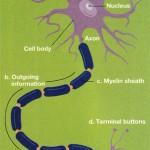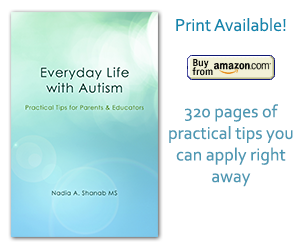By Nadia Shanab | Uncategorized
There are three other conditions/diseases that may overlap with autism. Your child has been diagnosed with autism, but beware of other symptoms that may hide under the ASD ambrella. Epilepsy, Tourette Syndrome, and Mitocondrial Disease. The good new is that treatments administered to cure these conditions can also benefit your child with autism. 1-Is your
Tags: asperger's syndrome, autism, diagnosis, early intervention, epilepsy, health, Mitchondrial disease, parenting, research, symptoms of autism, tips, Tourette Syndrome
Posted in Uncategorized | Comments Off on Beware of 3 Conditions Overlapping with Autism
By Nadia Shanab | autism
This is a summary of one of the sessions that I have attended at the Morgan Autism Center last September. The speaker, Jill Escher, narrates her own story of struggle and discoveries. She has 2 kids with “idiopathisc autism”. It is a very informative and eye-opening story that all parents should read. What causes autism
Tags: asperger's syndrome, autism, chemicals, communication, consequences, diagnosis, drugs, environmental, ferility treatment, genetics, health, IVF, neurodevelopmental conditions, pollution, research, smoking, social interaction, speech, symptoms of autism, toxins
Posted in autism | Comments Off on What Causes Autism? From Morgan Autism Center Conference
By Nadia Shanab | Uncategorized
Watch an interview with Temple Grandin that inspires “hope”. She briefly touches on most aspects of autism. templegrandin.com/ nadia shanab
Tags: asperger's syndrome, autism, communication, diagnosis, discipline, early intervention, flexibility, health, independence, organization, parenting, placement, research, rewards, schedule, sensory, social interaction, speech, symptoms of autism, Temple Grandin, tips
Posted in Uncategorized | Comments Off on A Message of Hope from Temple Grandin
By Nadia Shanab | Uncategorized
Individuals on the Autism Spectrum are known to be loners, anti-social, and have poor communication skills. Researchers found a corelation between a hormone that is tied to “bonding” called oxytocin, and the brain system that produce pleasure and motivation. This hormone is known as the “love” or “cuddle” chemical. Genetic changes in autistic children may
Tags: asperger's syndrome, autism, communication, diagnosis, early intervention, eye contact, neurotransmitter, oxytocin, parenting, research, serotonin, social interaction, tips
Posted in Uncategorized | Comments Off on How “Serotonin and Oxytocin” Affect The Social Behavior
By Nadia Shanab | Uncategorized
In a child development class I learned that a newborn’s brain has a huge number of connections between the cells (neurons). Imagine these connections forming a network. If some connections are more used than others (due to a heavy traffic on these communication lines), these pathways become well-established. The connections that are less used, get
Tags: autism, communication, diagnosis, early intervention, flexibility, neuron, neuroscientist, organization, parenting, research, social interaction
Posted in Uncategorized | Comments Off on How Is The Brain Wiring Created?
By Nadia Shanab | Uncategorized
It is a worldwide phenomena that the diagnosis with autism is on the rise, even in underdeveloped countries. What might the reason be? Diagnostic criteria are changing Screening tools have developed Increasing research on the topic Increased health services New environmental factors (pollution of air, oceans,…) Increased awareness of the condition Social factors I believe
Tags: autism, diagnosis, health, parenting, research, social interaction, symptoms of autism, tips
Posted in Uncategorized | Comments Off on Why Is Autism on The Rise?
By Nadia Shanab | Uncategorized
The answer to this question depends mainly on the child’s level of awareness of herself, both socially and cognitively. Some high-functioning children already know that they have autism. They know their condition very well, and are able to describe it precisely. This category of children knows its strengths as well as its weaknesses. Moreover, they
Tags: autism, communication, developmental pediatrician, diagnosis, health, parenting, placement, tips
Posted in Uncategorized | Comments Off on Should You Tell Your Child about Her Diagnosis?
By Nadia Shanab | Uncategorized
The ratio of boys to girls diagnosed with autism is around four to one. Is that really true? Is research biased to diagnose boys and overlook girls? Are girls able to camouflage the signs of autism? Research found that: male and female brains are different anyway, male’s brain has more tissue volume girls with the
Tags: autism, diagnosis, female brain, health, male brain, research, signs
Posted in Uncategorized | Comments Off on Autism and Gender
By Nadia Shanab | Uncategorized
The way ASD (Autism Spectrum Disorders) has always been diagnosed, is based on the professionals’ (pediatrians, psychologists, psychiatirics, specialized therapists…) social interaction with the child. Then, the professional’s opinion supported by parents observations are usually the traditional way to give a child a diagnosis. This novel technology can provide a more accurate, objective, and early
Tags: autism, communication, diagnosis, early intervention, health, parenting, research, sensory, social interaction, speech, symptoms of autism, techniques
Posted in Uncategorized | Comments Off on A New More Accurate Way to Diagnose and Treat Autism
By Nadia Shanab | Uncategorized
The new DSM 5 is due this month (May 2013). It is published by the American Psychiatric Association (APA). Three diagnosis will be removed: Aspergers Syndrome, PDD-NOS, and CDD. They will go under one diagnosis, autism. How is that going to affect parents, cliniacians, educators, advocates, and the children themselves with these conditions? Read the
Tags: asperger's syndrome, autism, communication, diagnosis, health, occupational therapy, parenting, research, symptoms of autism
Posted in Uncategorized | Comments Off on The New Diagnostic and Statistical Manual (DSM 5)


